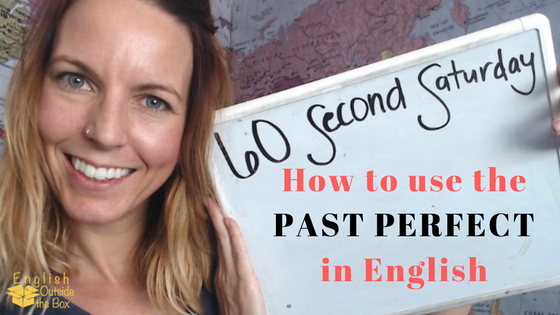
Past Perfect Practice: How to use the Past Perfect
The foundation of your English relies on your understanding of the time tenses in English. In order to effectively talk about the present, past, and future, you need to be able to differentiate these 3 tenses. However, within those 3 tenses, there are differences between the simple, progressive, and perfect structures. Are you comfortable with the differences?
A quick review is that simple tenses focus on the results of actions, while the progressive focuses on continuation and actions in progress. Perfect tenses are used to show connections in time. Today we’ll be reviewing the past perfect tense, and I’ll show you how to use the past perfect, as well as give you some more past perfect practice.
First, review this week’s 60 Second Saturday video, and then continue reading on for the lesson notes and practice.
Using The Past Perfect
The past perfect is used to connect 2 past actions, a past action and a past event, or a past action and a past time. The past perfect shows which action happened first (the earlier action in time). The second event, the event closer to the present, uses the simple past. To make a sentence in the past perfect, we need to use the auxiliary ‘had’ + past participle
Let’s look at these examples:
I had visited Tucson when we moved here.
(FIRST: I visited Tucson. SECOND: We moved here) The action of “visiting” happened first. The action of “moving” happened later, closer to the present.
By 2010, I had (already) traveled to 10 countries.
(FIRST: I traveled to 10 countries. SECOND: 2010 started) The action of “traveling” happened and finished before the year 2010 started.
Notice that if the time expression comes first, you need to use a comma ( , ) before the sentence with the past perfect. This is because the sentence with a time expression is called a dependent clause. The sentence with the past perfect is the main clause, and if this comes first, no comma is needed. Both sentence structures are OK to use and have no difference in meaning.
Additional Examples:
When this year started, I had been teaching for nearly 10 years. (I had been teaching for nearly 10 years when this year started.)
The concert had started by the time we found our seats. (By the time we found our seats, the concert had started.)
I had never seen a kangaroo before I went to Australia. (Before I went to Australia, I had never seen a kangaroo.)
Practice Makes Perfect
There is a lot more practice with the past perfect right on this blog! Today’s lesson was short and sweet, but if you need a little more explanation please review these lessons:
Understanding the Perfect Tenses
When you are feeling confident with your understanding of the past perfect, try and utilize these questions with your conversation partner, to answer on your own, and to follow in order to write your own sentence examples.
- What had you already done by the time this year started?
- What had you done before you read this English lesson?
- Had you already read some of my English lessons when you found this lesson today?
- Who had you learned English from before you learned with me?
- How long had you been in your career field when this year began?
I hope you understand a little more grammar today, and until next time,
Happy Studying ♥
Do you need to to understand more grammar for your professional English use? Better Communication with Grammar is a step-by-step grammar training course that will help you speak better English, with more accuracy, confidence and help you reach your career goals with English.
Sign up to receive more information below or sign up for the course by clicking here.
